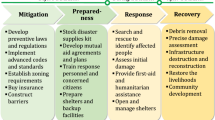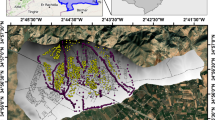Abstract
This paper aims to provide a comparative analysis of fuzzy rule-based systems and some standard statistical and other machine learning techniques in the context of the development of a decision support system (DSS) for the assessment of the severity of natural disasters. This DSS, which will be referred to as SEDD, has been proposed by the authors to help decision makers inside those Non-Governmental Organizations (NGOs) concerned with the design and implementation of international operations of humanitarian response to disasters. SEDD enables a relatively highly accurate and interpretable assessment on the consequences of almost every potential disaster scenario to be obtained through a set of easily accessible information about that disaster scenario and historical data about similar ones. Thus, although SEDD’s methodology is rather sophisticated, its data requirements are small, which, therefore, enables its use in the context of NGOs and countries requiring humanitarian aid. In this sense, SEDD opposes to some current tools which focuses on one phenomena-one place disaster scenarios (earthquakes in California, hurricanes in Florida, etc.) and/or have extensive and/or technologically sophisticated data requirements (real-time remote sensing information, exhaustive building census, etc.). Moreover, although focused on disaster response, SEDD can also be useful in other phases of disaster management, as disaster mitigation or preparedness. Particularly, the predictive accuracy and interpretability of SEDD fuzzy methodology is compared here in a disaster severity assessment context with those of multiple linear regression, linear discriminant analysis, classification trees and support vector machines. After an extensive validation over the EM-DAT disaster database, it is concluded that SEDD outperforms the methods above in the task of simultaneously providing an accurate and interpretable inference tool for the evaluation of the consequences of disasters.
Similar content being viewed by others
References
Aleskerov F, Say AI, Toker A, Akin H, Altay G (2005) A cluster-based decision support system for estimating earthquake damage and casualties. Disasters 29: 255–276
Amo A, Montero J, Molina E (2001) On the representation of recursive rules. Eur J Oper Res 130: 29–53
Amo A, Garmendia L, Gómez D, Montero J (2007) A spatial classification model for multicriteria analysis. In: Proceedings of IEEE symposium on computational intelligence in mulcticriteria decision making, IEEE Press, Piscataway, pp 348–353
Anderson JA (1995) An introduction to neural networks. MIT Press, Cambridge
Asghar S, Alahakoon D, Churilov L (2006) A dynamic integrated model for disaster management decision support systems. Int J Simulat 6(10–11): 95–114
Beringer J, Hüllermeier E (2008) Case-based learning in a bipolar possibilistic framework. Int J Intell Syst 23(10): 1119–1134
Billa L, Shattri M, Mahmud AR, Ghazali AH (2006) Comprehensive planning and the role of SDSS in flood disaster management in Malaysia. Disaster Prev Manage 15(2): 233–240
Cagliardi M, Spera C (1995) Towards a formal theory of model integration. Ann Oper Res 58: 405–440
Casillas J, Cordón O, Herrera F (2002) COR: A methodology to improve ad hoc data-driven linguistic rule learning methods by inducing cooperation among rules. IEEE Trans Syst Man Cybern Part B Cybern 32(4): 526–537
Cherkassky V, Mulier F (1998) Learning from data: concepts, theory and methods. Wiley, New York
Cortes C, Vapnik V (1995) Support-vector networks. Mach Learn 20: 273–297
Cutello V, Montero J (1999) Recursive connective rules. Int J Intell Syst 14: 3–20
Dolk D, Kottermann J (1993) Model integration and a theory of models. Decis Support Syst 9: 51–63
Drabek TE, Hoetmer GJ (1991) Emergency management: principles and practice for local government. International City Management Association, Washington, DC
Dubois D, Hüllermeier E, Prade H (2003) A note on quality measures for fuzzy association rules. In: Proceeding of IFSA-03, 10th Internat Fuzzy Systems Association World Congress, LNAI, vol 2715. Springer, Berlin, pp 677–648
Eguchi RT, Goltz JD, Seligson HA, Flores PJ, Blais NC, Heaton TH, Bortugno E (1997) Real-time loss estimation as an emergency response decision support system: the early post-earthquake damage assessment tool (EPEDAT). Earthq Spectra 13(4): 815–832
Eom HB, Lee SM, Kim EB, Somarajan C (1998) A survey of decision support system applications (1988–1994). J Oper Res Soc 49: 109–120
Figuera J, Greco S, Ehrgott M (2005) Multiple criteria decision analysis: state of the art surveys. Springer, Berlin
Gadomski AM, Bologna S, Costanzo GD, Perini A, Schaerf M (2001) Towards intelligent decision support systems for emergency managers: the IDS approach. Int J Risk Assess Manage 2(3/4): 224–242
Griekspoor A, Collins S (2001) Raising standards in emergency relief: how useful are Sphere minimum standards for humanitarian assistance. Br Med J 323: 740–742
Hullermeier E (2005) Fuzzy methods in machine learning and data mining: status and prospects. Fuzzy Sets Syst 156(3): 387–406
Iliadis L, Spartalis S (2005) Fundamental fuzzy relation concepts of a D.S.S. for the estimation of natural disasters’ risk (The case of a trapezoidal membership function). Math Comput Model 42: 747–758
Ishibuchi H, Nakashima T (1999) Voting in fuzzy rule-based systems for pattern classification problems. Fuzzy Sets Syst 103: 223–238
Kaburlasos VG (2006) Towards a unified modeling and knowledge-representation based on lattice theory—computational intelligence and soft computing applications. Studies in computational intelligence, vol 27. Springer, Heidelberg
Kecman V (2001) Learning and soft computing. MIT Press, Cambridge
Kecman V, Brooks J-P (2010) Locally linear support vector machines and other local models, WCCI 2010 IEEE World Congress on Computational Intelligence. Barcelona, Spain, pp 2615–2620
Klir GJ, Yuan B (1994) Fuzzy sets and fuzzy logic: theory and applications. Prentice-Hall, Upper Saddle River
Matisziwa TC, Murraya AT (2009) Modeling s–t path availability to support disaster vulnerability assessment of network infrastructure. Comput Oper Res 36(1): 16–26
Mendonça D, Beroggi EG, Wallace WA (2001) Decision support for improvisation during emergency response operations. Int J Emerg Manage 1: 30–38
Milly PC, Wetherald RT, Dunne KA, Delworth TL (2002) Increasing risk of great floods in a changing climate. Nature 415: 514–517
Montero J, Gómez D, Bustince H (2007) On the relevance of some families of fuzzy sets. Fuzzy Sets Syst 158: 2439–2442
Morrow BH (1999) Identifying and mapping community vulnerability. Disasters 23(1): 1–18
Olive DJ (2007) Prediction intervals for regression models. Comput Stat Data Anal 51: 3115–3122
Olsen GR, Carstensen N, Hoyen K (2003) Humanitarian crisis: what determines the level of emergency assistance? Media coverage, donor interest and the aid business. Disasters 27(2): 109–126
Ott RL (1993) An introduction to statistical methods and data analysis. Duxbury Press, Belmont
Tsoukiàs M, Tsoukiàs A (2008) Bipolar preference modeling and aggregation in decision support. Int J Intell Syst 23(9): 970–984
Pei Z, Resconi G, Van Der Wal AJ, Qin K, Xu Y (2006) Interpreting and extracting fuzzy decision rules from fuzzy information systems and their inference. Inform Sci 176(13): 1869–1897
Prins EM, Menzel WP (2004) Geostationary satellite detection of biomass burning in South America. Intl J Remote Sens 13: 49–63
Repoussis PP, Paraskevopoulos DC, Zobolas G, Tarantilis CD, Ioannou G (2009) A web-based decision support system for waste lube oils collection and recycling. Eur J Oper Res 195: 676–700
Rodriguez JT, Vitoriano B, Montero J, Omaña A et al (2008) A decision support tool for humanitarian organizations in natural disaster relief. In: Ruan D (eds) Computational intelligence in decision and control. World Scientific, Singapore, pp 600–605
Rodriguez JT, Montero J, Vitoriano B, Lopez V (2009) An inductive methodology for data-based rules building. In: Rossi F, Tsoukiàs A (eds) Algorithmic decision theory, LNAI 5783. Springer, Berlin, pp 424–433
Rodriguez JT, Vitoriano B, Montero J (2010a) A natural-disaster management DSS for Humanitarian Non-Governmental Organisations. Knowledge Based Syst 23(1): 17–22
Rodriguez JT, Vitoriano B, Montero J (2010b) A general methodology for data-based rule building and its application to natural disaster management. Comput Oper Res. doi:10.1016/j.cor.2009.11.014
Rodriguez JT (2010) Classification of disasters and emergencies using bipolar knowledge representation. PhD thesis, Complutense University of Madrid, Madrid
Rokach L, Maimon O (2008) Data mining with decision trees: theory and applications. World Scientific, New York
Ruspini EH (1969) A new approach to clustering. Inform Control 15: 22–32
Schneider PJ, Schauer BA (2006) Hazus—its development and its future. Natural Hazards Rev 7(2): 40–44
Schweizer B, Sklar A (1983) Probabilistic metric spaces. North–Holland Elsevier, New York
Shima JP, Warkentina M, Courtney JF, Power DJ, Sharda R, Carlsson C (2002) Past, present, and future of decision support technology. Decis Support Syst 33(2): 111–126
Stoddard A (2003) Humanitarian NGOs: challenges and trends. In: Macrae J, Harmer A (eds) Humanitarian action and the ‘global war on terror’: a review of trends and issues, ODI, HPG Report 14, London pp 25–36
Todini E (1999) An operational decision support system for flood risk mapping, forecasting and management. Urban Water 1: 131–143
Tufekci S (1995) An integrated emergency management decision support system for hurricane emergencies. Saf Sci 20: 39–48
Van Wassenhove LN (2006) Humanitarian aid logistics: supply chain management in high gear. J Oper Res Soc 57: 475–489
Vitoriano B, Ortuño MT, Tirado G, Montero J (2010) A multi-criteria optimization model for humanitarian aid distribution. J Global Optimi (accepted). doi:10.1007/s10898-010-9603-z
Vogt M, Kecman V (2004) An active-set algorithm for support vector machines in nonlinear system identification. In: Proceedings of the 6th IFAC symposium on nonlinear control systems (NOLCOS 2004). Stuttgart, Germany, pp 495–500
Vogt M, Kecman V (2005) Chapter, Active-set methods for support vector machines. in a Springer-Verlag book, Support vector machines: theory and applications. In: Wang L (ed) Series: studies in fuzziness and soft computing, vol 177, pp 133–158
Wallace WA, De Balogh F (1985) Decision support systems for disasters management. Public Admin Rev 45: 134–147
Author information
Authors and Affiliations
Corresponding author
Rights and permissions
About this article
Cite this article
Rodríguez, J.T., Vitoriano, B., Montero, J. et al. A disaster-severity assessment DSS comparative analysis. OR Spectrum 33, 451–479 (2011). https://doi.org/10.1007/s00291-011-0252-5
Published:
Issue Date:
DOI: https://doi.org/10.1007/s00291-011-0252-5




